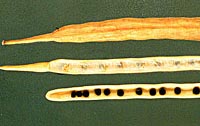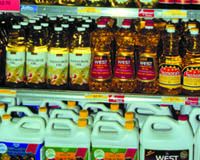
Canola is a member of the Crucifarea
family. This family includes broccoli, cabbage and mustard seed. Canola grows 1 to 1.5m high and has a seed pod with 15 to 40 small round
seeds. The seeds have a high percentage of oil and therefore canola is classed as a type of oilseed. There are two types of canola;
the short growing season Polish type (Brassica rapa/campestris) and the longer season Argentine type (Brassica napus). The Polish
type is the predominant kind grown in Saskatchewan.
Where is it produced in Saskatchewan?
Canola can be grown in various locations in the province depending on soil fertility and weather conditions. The day to maturity range from 85 to 87 for the Polish varieties and 98 to 102 days for the Argentine varieties. While the Argentine varieties take longer to mature, they typically produce a higher yield.
How much do we produce?
Canola is fifth in the world trade in agricultural crops, after rice, wheat, maize and cotton. Canola is Canada's third most important grain export, after wheat and barley.
In the 1940s, Canadian farmers planted 6000 acres of rapeseed per year. In the 1990s, farmers are planting about 10.5 million acres of canola annually. About 20% of Saskatchewan field crops are canola. Saskatchewan produces approximately 40% of the Canadian production of canola.
Canola oil accounts for 63% of the total edible vegetable oils produced in Canada, compare to 24% for soybean oil and 4% for sunflower oil.

What does it look like when I
use it?
Canola is pressed and the oil is used for cooking and salad oils or processed into margarine. Canola
is 42 to 45% oil, and 23% protein. It contains monosaturated fat (62%) and polyunsaturated
fat (32%). These fats are essential sources of energy, and may actually lower the risk of heart disease.
Canola oil has the lowest level of saturated fats of the available vegetable oils at 6-7%. It has won health and nutrition awards
because of its low saturates and balance of fatty acids.
The canola seed is processed through a complex series of steps which results in four groups of canola products:
- canola meal - leftover after the oil has been pressed out of the seed; used as a high protein and energy feed supplement for livestock
- crude degummed oil
- canola oil products packaged for the consumer -margarine is packaged for sale in convenient sizes; canola oil is low in cholesterol
- bulk canola oil
Trials are underway to use canola
as a diesel fuel, a hydraulic oil and as a biodegradable chain
saw oil.
How is it produced?
| 